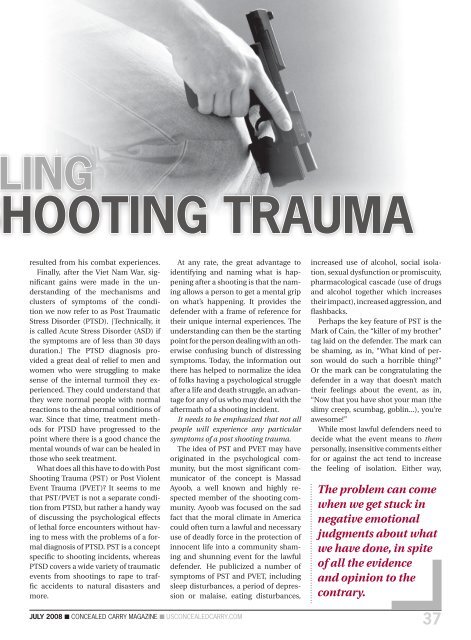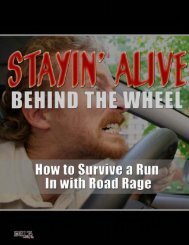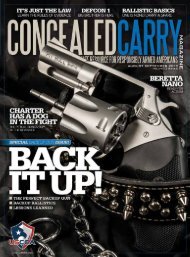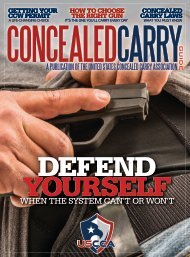Download This Issue - US Concealed Carry
Download This Issue - US Concealed Carry
Download This Issue - US Concealed Carry
You also want an ePaper? Increase the reach of your titles
YUMPU automatically turns print PDFs into web optimized ePapers that Google loves.
ing<br />
hooting Trauma<br />
resulted from his combat experiences.<br />
Finally, after the Viet Nam War, significant<br />
gains were made in the understanding<br />
of the mechanisms and<br />
clusters of symptoms of the condition<br />
we now refer to as Post Traumatic<br />
Stress Disorder (PTSD). [Technically, it<br />
is called Acute Stress Disorder (ASD) if<br />
the symptoms are of less than 30 days<br />
duration.] The PTSD diagnosis provided<br />
a great deal of relief to men and<br />
women who were struggling to make<br />
sense of the internal turmoil they experienced.<br />
They could understand that<br />
they were normal people with normal<br />
reactions to the abnormal conditions of<br />
war. Since that time, treatment methods<br />
for PTSD have progressed to the<br />
point where there is a good chance the<br />
mental wounds of war can be healed in<br />
those who seek treatment.<br />
What does all this have to do with Post<br />
Shooting Trauma (PST) or Post Violent<br />
Event Trauma (PVET)? It seems to me<br />
that PST/PVET is not a separate condition<br />
from PTSD, but rather a handy way<br />
of discussing the psychological effects<br />
of lethal force encounters without having<br />
to mess with the problems of a formal<br />
diagnosis of PTSD. PST is a concept<br />
specific to shooting incidents, whereas<br />
PTSD covers a wide variety of traumatic<br />
events from shootings to rape to traffic<br />
accidents to natural disasters and<br />
more.<br />
At any rate, the great advantage to<br />
identifying and naming what is happening<br />
after a shooting is that the naming<br />
allows a person to get a mental grip<br />
on what’s happening. It provides the<br />
defender with a frame of reference for<br />
their unique internal experiences. The<br />
understanding can then be the starting<br />
point for the person dealing with an otherwise<br />
confusing bunch of distressing<br />
symptoms. Today, the information out<br />
there has helped to normalize the idea<br />
of folks having a psychological struggle<br />
after a life and death struggle, an advantage<br />
for any of us who may deal with the<br />
aftermath of a shooting incident.<br />
It needs to be emphasized that not all<br />
people will experience any particular<br />
symptoms of a post shooting trauma.<br />
The idea of PST and PVET may have<br />
originated in the psychological community,<br />
but the most significant communicator<br />
of the concept is Massad<br />
Ayoob, a well known and highly respected<br />
member of the shooting community.<br />
Ayoob was focused on the sad<br />
fact that the moral climate in America<br />
could often turn a lawful and necessary<br />
use of deadly force in the protection of<br />
innocent life into a community shaming<br />
and shunning event for the lawful<br />
defender. He publicized a number of<br />
symptoms of PST and PVET, including<br />
sleep disturbances, a period of depression<br />
or malaise, eating disturbances,<br />
increased use of alcohol, social isolation,<br />
sexual dysfunction or promiscuity,<br />
pharmacological cascade (use of drugs<br />
and alcohol together which increases<br />
their impact), increased aggression, and<br />
flashbacks.<br />
Perhaps the key feature of PST is the<br />
Mark of Cain, the “killer of my brother”<br />
tag laid on the defender. The mark can<br />
be shaming, as in, “What kind of person<br />
would do such a horrible thing?”<br />
Or the mark can be congratulating the<br />
defender in a way that doesn’t match<br />
their feelings about the event, as in,<br />
“Now that you have shot your man (the<br />
slimy creep, scumbag, goblin...), you’re<br />
awesome!”<br />
While most lawful defenders need to<br />
decide what the event means to them<br />
personally, insensitive comments either<br />
for or against the act tend to increase<br />
the feeling of isolation. Either way,<br />
The problem can come<br />
when we get stuck in<br />
negative emotional<br />
judgments about what<br />
we have done, in spite<br />
of all the evidence<br />
and opinion to the<br />
contrary.<br />
JULY 2008 n CONCEALED CARRY MAGAZINE n <strong>US</strong>CONCEALEDCARRY.COM<br />
37
















